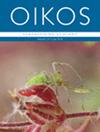Pattern and driver of the compositional variations in a tropical cloud forest: comparing vascular epiphytes with terrestrial woody plants
IF 3.1
2区 环境科学与生态学
Q2 ECOLOGY
引用次数: 0
Abstract
β-diversity patterns (the compositional variations across sites) and their drivers are the major concerns of biodiversity research and conservation practices, whereas such information remains scarce for vascular epiphytes, especially in tropical forest communities. This study aimed to reveal the pattern and driving process of the compositional variations of vascular epiphytes in a tropical cloud forest on Hainan island, southern China, and their differences from those of terrestrial woody plants. To this end, we quantified their between-habitat compositional variations and distinguished the underlying components of β-diversity (nestedness and turnover). We then examined the relative roles of niche-based and neutral processes in driving the compositional variations by using a null model approach. Our results showed that the between-habitat compositional variations were significant for both plant assemblages and stronger in vascular epiphytes than in terrestrial woody plants. The turnover component of β-diversity was significantly stronger in terrestrial woody plants, accounting for 73.16–80.08% of the variations. By contrast, the nestedness component was significantly stronger in vascular epiphytes and characterized 46.82–67.5% of the variations. Besides, the compositional variations of both plant assemblages, especially terrestrial woody plants, were generally poorly fitted by the simulated niche-based scenarios but well fitted by the simulated neutral scenarios. Overall, the compositional variations of both plant assemblages were significant and mainly due to dispersal limitation, albeit to varying degrees. Hence, further studies of these plant assemblages at local scales should not be ideologically limited to the niche-based framework. Moreover, the stronger nestedness observed in vascular epiphytes suggests the greater importance of prioritizing conservation efforts in the species-rich habitats for these plants.热带云雾林成分变化的模式和驱动因素:比较维管附生植物和陆生木本植物
β多样性模式(不同地点之间的成分变化)及其驱动因素是生物多样性研究和保护实践的主要关注点,而对于维管附生植物,尤其是热带森林群落中的维管附生植物,这方面的信息仍然很少。本研究旨在揭示中国南部海南岛热带云雾林中维管附生植物成分变化的模式和驱动过程,以及它们与陆生木本植物成分变化的差异。为此,我们量化了它们在不同生境之间的成分变化,并区分了β多样性的基本成分(嵌套度和周转率)。然后,我们采用空模型方法研究了基于生态位的过程和中性过程在驱动成分变化中的相对作用。我们的研究结果表明,栖息地之间的组成变化对两种植物群落都有显著影响,而且维管附生植物的变化比陆生木本植物更大。在陆生木本植物中,β多样性的周转成分明显更强,占变化的73.16%-80.08%。相比之下,维管附生植物的嵌套性成分明显更强,占变化的 46.82%-67.5%。此外,两种植物群落的组成变化,尤其是陆生木本植物的组成变化,在基于生态位的模拟情景中的拟合程度普遍较低,但在模拟中性情景中的拟合程度较高。总体而言,这两个植物群的成分变化显著,主要是由于扩散限制造成的,只是程度不同而已。因此,在局部范围内对这些植物组合的进一步研究不应局限于基于生态位的框架。此外,在维管附生植物中观察到的更强的嵌套性表明,在物种丰富的栖息地优先保护这些植物更为重要。
本文章由计算机程序翻译,如有差异,请以英文原文为准。
求助全文
约1分钟内获得全文
求助全文
来源期刊

Oikos
环境科学-生态学
CiteScore
6.20
自引率
5.90%
发文量
152
审稿时长
6-12 weeks
期刊介绍:
Oikos publishes original and innovative research on all aspects of ecology, defined as organism-environment interactions at various spatiotemporal scales, so including macroecology and evolutionary ecology. Emphasis is on theoretical and empirical work aimed at generalization and synthesis across taxa, systems and ecological disciplines. Papers can contribute to new developments in ecology by reporting novel theory or critical empirical results, and "synthesis" can include developing new theory, tests of general hypotheses, or bringing together established or emerging areas of ecology. Confirming or extending the established literature, by for example showing results that are novel for a new taxon, or purely applied research, is given low priority.
 求助内容:
求助内容: 应助结果提醒方式:
应助结果提醒方式:


